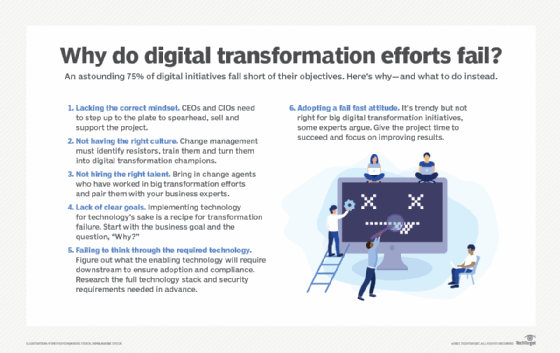
Rymden - stock.adobe.com
How to overcome digital transformation fatigue
For many employees, poorly executed digital transformation projects lead to fatigue. Learn effective methods for maintaining project momentum from start to finish.
Even good things -- such as digital transformations -- can become exhausting if overdone.
The lasting benefits of a successful digital transformation are compelling, such as improved customer experience, streamlined operations and an increased competitive edge.
However, many enterprise and IT leaders report that the digital transformation process is burning out some of their best IT professionals, line department managers and workers.
Causes, signs of fatigue
The first step to overcoming digital transformation fatigue is understanding what it is, as well as the most common causes and signs.
Digital transformation fatigue -- or transformation fatigue, for short -- is a concept that explains the exhaustion workers might feel due to continuous efforts to adapt to digital changes imposed by their organizations.
In a nutshell, the cause of transformation fatigue is trying to do too much, too often. Enterprises with a solid record of success say that more than two at any given time is almost a bad thing, and risking more than one per year affects the same IT and line teams. There should be enough time between projects to give everyone involved a break.
Transformations -- by definition -- can't be a regular occurrence.
Even if a company tries to undertake a few, smaller projects, digital transformation fatigue might still arise.

Signs that workers are feeling digital transformation fatigue include the following:
- Workers complain their time is being wasted.
- They feel they're asked to complete the same tasks multiple times.
- They feel unappreciated.
- They feel their concerns aren't taken seriously.
- They feel key people are difficult to work with.
CIOs and other senior leaders can take action to overcome and help prevent digital transformation fatigue. Here are five important tips.
1. Include only necessary project participants
Project leaders should avoid assigning multiple employees to work on a project. Enterprises say it's common for transformation projects to include as many as twice the number of workers needed. Adding more employees than necessary means loss of critical project time, spending time on lengthy explanations and managing objections from workers. Consider the following steps:
- Assign workers to the project only if they're given actionable tasks.
- Limit the number of employees asked to attend project meetings to those either directly involved or those responsible for approving milestones.
- Manage distribution lists for project documents and limit access to project management websites for those on the approved distribution lists.
2. Develop the right documentation
A key step toward avoiding digital transformation fatigue is creating appropriate documentation. Technical documentation helps employees in the future to optimally manage intra-project dependencies. Enterprises say that documentation is the foundation of project communications. To proactively address this, consider the following:
- For each project task, record the upstream relationships, or what requirements a task depends on, and downstream relationships, or what other tasks depend on this task. These records ensure that any changes made during the completion of the task fully consider the effects on related tasks. This step can also identify changes where the ripple effect is too great and whether that change might create risk of fatigue and pushback.
- Specify the criteria for task completion and success, such as defining measurable objectives, deliverables, quality standards and any other relevant factors. Note the specific employees responsible for applying those determinations and limit this group to those involved.
- Identify major milestones, where project information and status can be shared more broadly, and what specific information can be shared with other groups.
3. Share only selective and concise updates
Project leaders should strive to establish and control lines of communication. Employees need to know enough to do their jobs properly, but they don't need detailed information on everything going on. Too much information can be a major cause of fatigue. Information overload can encourage casual exchanges that might make project management more difficult, fostering potential misunderstandings and errors. Take the following steps:
- Assign a specific team to each task and designate one or more leaders, based on the number of workers and roles involved. These leaders will help guide their teams and act as the main point of contact for functions dependent on their team's success, as outlined in the task documentation.
- Group similar tasks according to relationships and dependencies and assign one of the task leaders as the leader for the grouped tasks. The leaders of these grouped tasks are then responsible for coordinating with project leaders.
- For any task involving significant activity for both IT and line personnel, ensure that IT and line leaders collaborate on inter-task communications and any reports each respective leader presents to their management team.
4. Simplify problem reports
Project leaders that establish, document and get approval for a clear procedure for addressing problem reports and complaints are essential. Clearly outlining the steps for reporting problems reduces confusion and can lead to a smoother resolution process. Be sure the process addresses the following concerns:
- To whom each task worker should report a problem, and when such a report should be made. Is suspicion enough or should task leaders take time to validate the problem?
- At what point should a task problem be escalated from the task group and onward to the project leaders? Task leaders should avoid other avenues of escalation, if possible.
- Which of the project leaders will take ownership of the problem resolution process and what determines a successful resolution? Generally, that will depend on whether the problem exists within a task, a task group including upstream and downstream dependencies or the overall project.
- Determine a reasonable timeframe for delaying any downstream tasks until the issue is resolved. It's incredibly frustrating to have time or subsequent work wasted because of an upstream problem.
- How to report and address disagreements with a decision or another team member. An anonymous process can prevent disruptive gossip and limit complaints.
5. Establish a process to handle project changes
Project leaders should establish a clear process for handling proposed or mandatory changes to project requirements. Not only are changes in specifications frustrating to everyone involved, but these requests can accumulate and grow into scope creep, which puts the entire project at risk. Review each of the following:
- Consider how to introduce and review change proposals so that only truly essential changes are communicated to and considered by the project team. Even suggestions of minimal change -- especially rejected ones -- can be disruptive.
- If making a change is approved, how can the project leader -- together with task group leaders -- map the scope of change along the chain of dependencies identified in project documentation and work out the details of how to implement it?
- When does the change justify a mass meeting of project personnel, and when does it justify an explicit redo of past phases or even the entire project? Justification is critical for any change, especially for changes that require redoing something already done.
A cohesive project team, a well-documented project with clear communication, and effective management of external challenges will significantly boost project morale and minimize the risk of an unfavorable outcome.
Tom Nolle is founder and principal analyst at Andover Intel, a consulting and analysis firm that looks at evolving technologies and applications first from the perspective of the buyer and the buyer's needs. By background, Nolle is a programmer, software architect, and manager of software and network products, and he has provided consulting services and technology analysis for decades.








